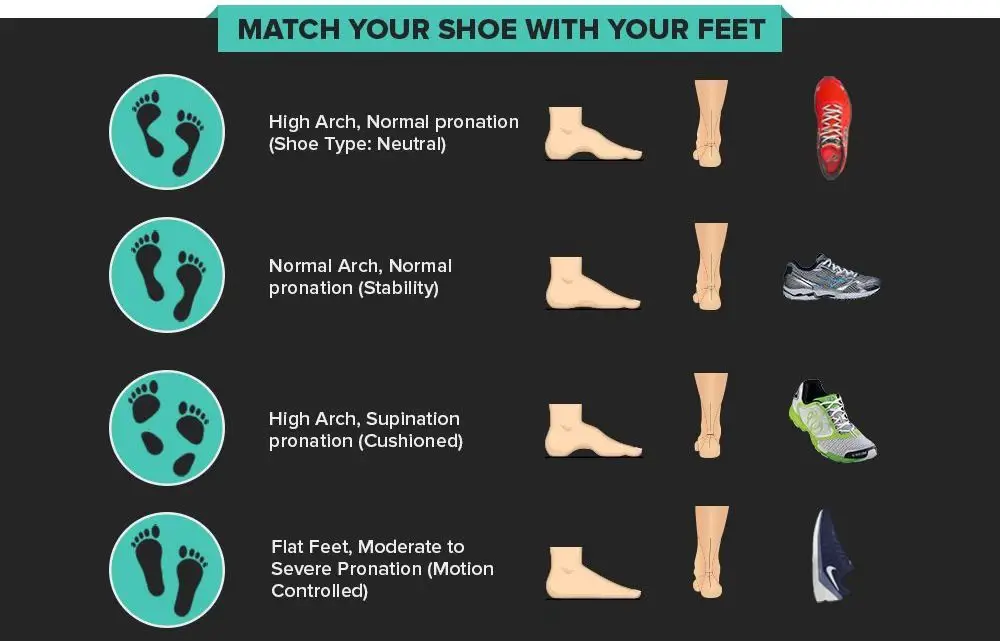Running is one of the most simple and effective ways to keep us in shape. Just put on your favorite running shoe, get out of the door, and give yourself one of the best workout possible.
Awesome right?
Until you observe carefully that every year runners suffer more injuries than others.
And you know what…many times these injuries are somehow related to their gait.
Although not easy, a simple tweak like changing your running shoes can help you to improve your gait.
This brings us to the question…
How to choose running shoes to improve your gait?
To choose a running shoe to improve your gait, first, you need to find out what is your gait. This can be either pronation or overpronation, neutral and under pronation. Once you know that, choose either stability, motion control, or neutral running shoe. To understand your pronation, check with the fitting expert in your nearest local store.

You may think it is complicated to choose a running shoe to improve your gait, but in reality, it is easy.
You only need the correct steps to find the best running shoe for your type of pronation.
And we tried to provide you with those steps in as simple words as possible.
Steps to choose running shoes for gait improvement
Choosing a running shoe to improve your gait is not very difficult.
However, it starts with one of the most basic steps, gait analysis.
Your chance of having a painful or painless run, fully depends on the shoe you select.
How to find your gait?
If you want to find out your gait, use any of these below methods:
Ask your buddy to help: In this method, you ask your buddy to observe the way you run from behind.
What he/she is trying to understand is how your knees are moving when you are running.
If your knees are coming in, you have overpronation, if it is turning out, you are an underpronator.
Otherwise, you have neutral pronation.
Observe your pains: As runners, we are often tempted to ignore our pains.
We falsely believe that it will go away. However, that may or may not be true but it can give you definite clues to understand your gait better.
If you have pain on the side of your shin or knees, you may be overpronating. If your ankle hurts, you may be an underpronator.
Check the wear pattern of your shoe: This is one of the surest ways to understand your pronation.
If the inside edge of the forefeet of the sole seems worn out, then you are an overpronator.
If the wear is on the outer edge, then you are an underpronator.
Check the tilt of your old shoes: This is also a very effective method. Here you will line up your old shoes and observe them from behind.
- Shoes sit flat on the ground, you are a neutral runner.
- Shoes tilt inwards, you are an overpronator.
- Shoes tilt outwards, then you are an underpronator.
Wet-foot test: This can be a supplemental method and will not give you a clear indication of your pronation.
In this method, you will put water on your feet and stand on a piece of paper.
Check, the pattern made on the paper.

If you are a high arched person, most of the time you will be underpronator.
If you have flat feet or a low arch, most of the time you will be an overpronator.
However, please use any of the above methods to confirm your conclusion.
Get a professional gait analysis done: Walk into your nearest sports shoe store or to your physiotherapist’s office.
Ask them to help you to find out your gait.
Match your gait to your shoe
Now that you know your pronation, here are the shoes, that can help you with your gait:
Stability Shoes – These running shoes are for runners with mild to moderate overpronation.
Here you will often see a firm “post” to reinforce the arch side of each midsole.
They typically have thicker collar and tongue to keep your ankles stable.
Motion Control – These shoes are suitable for runners who have moderate to severe overpronation.
They are typically more rigid and heavier than other shoes and also have more cushioning.
Some of them have built-in roll bar technology which limits the rolling of the feet inside the shoe.
Neutral/Cushion – These running shoes are meant for runners with neutral to underpronation.
They are good with shock absorption and are essential for underpronators. Their ankle joint tends to be stiffer than other types of runners.
Minimalist/Barefoot – These are suitable for any kind of runner and comes with almost no cushioning.
Minimalist running shoes come with a tougher outsole and protects your feet from stones and debris on the running path.

Related Questions
What is a runner’s gait?
Runner’s gait is the way your foot rolls when it touches the ground while running.
And if you are wondering, here are the different types of pronation that you can have:
Overpronation – This is also called pronation. In this type of pronation, your feet will roll inside, once touching the ground.
These runners tend to have a flat or low foot arch. Also, they are prone to injuries like ITBS, Bunions, Plantar Fasciitis, and Shin splints.
Neutral – When your feet touch the ground, it is almost at a 90 degree to your leg.
You are less susceptible to injuries from your foot rolling. You may face problems mainly if you don’t have the correct running form.
Underpronation – Here, when your feet touch the ground, it rolls outward. Many times, such runners have stiff ankle joints.
You may also have a higher arch and will have to use running shoes with more arch support. Ankle pain is common with such runners.

Can you change your running gait?
You can change your running gait however, you should only think about it if you are getting injured repeatedly.
When you are using a particular gait throughout your life, chances are, the rest of your body has become used to it.
However, if you want to improve your running then according to experts you should focus more on improving your cadence.
A recreational runner should focus on achieving a cadence of 150 strides per minute.
So, if you are still not there, this should be your target.
If you are running, improving, and not getting injured, then there is no point in changing your running gait.
Can you change your running style?
There has been a lot of debate over the past years over the optimal running form.
It is true that, if you land on your forefoot/midfoot, your running efficiency will improve.
Also, if you are a heel striker, then chances are you will end up having knee or hip injuries earlier than others.
However, suddenly changing your running form may have a more bad impact than good.
Your body will have no idea of what is going on and your chances of making mistakes are more.
So, it’s better to transition gracefully and slowly. This way you will be able to avoid a lot of injuries as well.
References
Roca-Dols, Andrea, et al. “Effect of the cushioning running shoes in ground contact time of phases of gait.” Journal of the mechanical behavior of biomedical materials 88 (2018): 196-200.
Chen, C. H., Tu, K. H., Liu, C., & Shiang, T. Y. (2014). Effects of forefoot bending elasticity of running shoes on gait and running performance. Human Movement Science, 38, 163-172.
Higginson, Brian K. “Methods of running gait analysis.” Current sports medicine reports 8, no. 3 (2009): 136-141.
Kerrigan DC, Franz JR, Keenan GS, Dicharry J, Della Croce U, Wilder RP. The effect of running shoes on lower extremity joint torques. Pm&r. 2009 Dec 1;1(12):1058-63.
Asplund, Chad A., and David L. Brown. “The running shoe prescription: fit for performance.” The physician and sportsmedicine 33.1 (2005): 17-24.

Madhusree Basu
Author, Admin
Blogger and a fitness enthusiast. She loves running and Yoga and everything in between. She started running to manage her weight and to eat to her heart’s content. A true foodie at heart she shares whatever knowledge she has gained throughout the years about weight management and fitness.
